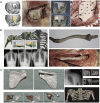Functional engineering strategies of 3D printed implants for hard tissue replacement
- PMID: 36683758
- PMCID: PMC9845531
- DOI: 10.1093/rb/rbac094
Functional engineering strategies of 3D printed implants for hard tissue replacement
Abstract
Three-dimensional printing technology with the rapid development of printing materials are widely recognized as a promising way to fabricate bioartificial bone tissues. In consideration of the disadvantages of bone substitutes, including poor mechanical properties, lack of vascularization and insufficient osteointegration, functional modification strategies can provide multiple functions and desired characteristics of printing materials, enhance their physicochemical and biological properties in bone tissue engineering. Thus, this review focuses on the advances of functional engineering strategies for 3D printed biomaterials in hard tissue replacement. It is structured as introducing 3D printing technologies, properties of printing materials (metals, ceramics and polymers) and typical functional engineering strategies utilized in the application of bone, cartilage and joint regeneration.
Keywords: 3D printing; additive manufacturing; bone regeneration; functional engineering; hard tissue replacement.
© The Author(s) 2022. Published by Oxford University Press.
Figures











Similar articles
-
Current status of three-dimensional printing inks for soft tissue regeneration.Tissue Eng Regen Med. 2016 Dec 17;13(6):636-646. doi: 10.1007/s13770-016-0125-8. eCollection 2016 Dec. Tissue Eng Regen Med. 2016. PMID: 30603445 Free PMC article. Review.
-
Recent Advances in Biomaterials for 3D Printing and Tissue Engineering.J Funct Biomater. 2018 Mar 1;9(1):22. doi: 10.3390/jfb9010022. J Funct Biomater. 2018. PMID: 29494503 Free PMC article. Review.
-
Advancements in 3D printing technologies for personalized treatment of osteonecrosis of the femoral head.Mater Today Bio. 2025 Feb 4;31:101531. doi: 10.1016/j.mtbio.2025.101531. eCollection 2025 Apr. Mater Today Bio. 2025. PMID: 40026627 Free PMC article. Review.
-
Nanomaterial integrated 3D printing for biomedical applications.J Mater Chem B. 2022 Sep 28;10(37):7473-7490. doi: 10.1039/d2tb00931e. J Mater Chem B. 2022. PMID: 35993266 Review.
-
Biomaterials in bone and mineralized tissue engineering using 3D printing and bioprinting technologies.Biomed Phys Eng Express. 2021 Oct 7;7(6). doi: 10.1088/2057-1976/ac21ab. Biomed Phys Eng Express. 2021. PMID: 34438382 Review.
Cited by
-
Replace or Regenerate? Diverse Approaches to Biomaterials for Treating Corneal Lesions.Biomimetics (Basel). 2024 Mar 28;9(4):202. doi: 10.3390/biomimetics9040202. Biomimetics (Basel). 2024. PMID: 38667213 Free PMC article. Review.
-
Multifunctional surface of the nano-morphic PEEK implant with enhanced angiogenic, osteogenic and antibacterial properties.Regen Biomater. 2024 Jun 17;11:rbae067. doi: 10.1093/rb/rbae067. eCollection 2024. Regen Biomater. 2024. PMID: 38974666 Free PMC article.
-
Fused Deposition Modeling Printed PLA/Nano β-TCP Composite Bone Tissue Engineering Scaffolds for Promoting Osteogenic Induction Function.Int J Nanomedicine. 2023 Oct 17;18:5815-5830. doi: 10.2147/IJN.S416098. eCollection 2023. Int J Nanomedicine. 2023. PMID: 37869064 Free PMC article.
-
3D printing materials and 3D printed surgical devices in oral and maxillofacial surgery: design, workflow and effectiveness.Regen Biomater. 2024 Jun 27;11:rbae066. doi: 10.1093/rb/rbae066. eCollection 2024. Regen Biomater. 2024. PMID: 39169972 Free PMC article. Review.
-
Enhancing cell adhesive and antibacterial activities of glass-fibre-reinforced polyetherketoneketone through Mg and Ag PIII.Regen Biomater. 2023 Jul 12;10:rbad066. doi: 10.1093/rb/rbad066. eCollection 2023. Regen Biomater. 2023. PMID: 37489146 Free PMC article.
References
-
- Roseti L, Parisi V, Petretta M, Cavallo C, Desando G, Bartolotti I, Grigolo B.. Scaffolds for bone tissue engineering: state of the art and new perspectives. Mater Sci Eng C Mater Biol Appl 2017;78:1246–62. - PubMed
-
- Marie P. Physiology of bone tissue. Immuno-Anal Biol Spec 1992;7:17–24.
Publication types
LinkOut - more resources
Full Text Sources

